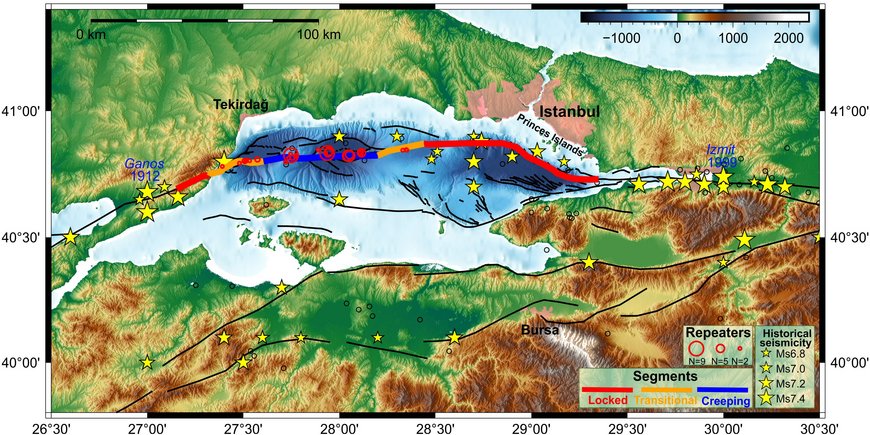Summary
The Sea of Marmara south of the 16-million metropolis of Istanbul hosts the boundary between the Eurasian and Anatolian tectonic plates, the so-called Main Marmara Fault (MMF). This segment of the North Anatolian Fault Zone has not been activated for a long time, so that an earthquake with a large magnitude of more than M > 7 is overdue. A team led by Dirk Becker and Marco Bohnhoff from the German Research Center for Geosciences in Potsdam (GFZ) provides the first systematic pattern of deformation with locked and creeping portions along the ‘Marmara seismic gap’ in the journal Geophysical Research Letters. The basis for this is a new, high-resolution seismicity catalog compiled using the latest data processing techniques. While slowly and aseismically creeping fault sections host small recurring earthquakes on local spots of brittle material, so-called “repeaters”, such repeaters don’t occur along locked segments that accumulate strain energy until rock strength is reached and a larger earthquake starts.
The researchers found that below the western Sea of Marmara most of the tectonic energy is released by slow and thus aseismic creep. Towards the East the fraction of creep becomes systematically smaller until the fault is completely locked immediately south of Istanbul. In view of the seismic hazard in the region, the study thus provides important information for earthquake scenarios and thus the assessment of the seismic risk and the hazard for the megacity.
The danger of earthquakes in the Istanbul region
The Main Marmara Fault (MMF) south of Istanbul, a city with a population of 16 million, is referred to as a “seismic gap”: A very strong earthquake with a magnitude of M > 7 is overdue there. This can be concluded from historical earthquake catalogues, allowing to conclude that such an event on average occurs about every 250 years. The last large earthquake in the region took place in 1766.
An important parameter to characterize an active fault can be derived from whether and where the fault is locked or partially creeping. Locked portions, unlike creeping segments, accumulate tectonic deformation energy until rock strength is reached. They are then often the starting point for strong earthquakes. If the starting point is near urban centers, the early warning time is correspondingly shorter.
Seismic repeaters as indicators for creeping zones
When tectonic plates move against each other along their contact zone, they may deform aseismically by what is known as creep. Within this creep zone, there are sometimes brittle areas that are loaded by surrounding creep and then break repeatedly in the form of smaller earthquakes. These earthquakes occur again and again in exactly the same place, with the same waveform and similar strength, and are therefore also referred to as “seismic repeaters”. They are thus indicators of creeping areas. These repeaters do not occur along locked segments.
The search for earthquake repeaters
To identify creeping areas below the Sea of Marmara, the researchers therefore specifically searched for such seismic repeaters. The team included Dirk Becker, Patricia Martínez-Garzón, Christopher Wollin and Marco Bohnhoff from the German Research Center for Geosciences in Potsdam, and Tuğbay Kılıç from the Turkish Disaster and Emergency Management Authority AFAD.
As a basis for their analyses, they have significantly expanded the existing catalog of earthquakes in the Marmara region so that it now completely covers the years 2006 to 2020. It now records 13,812 events. They were all relocated using new algorithms, so-called 'template matching', and their characteristics were examined using various criteria. On this basis, repeater earthquakes can be distinguished from normal earthquakes, which occur irregularly in terms of space and time.
Overall, the research team identified 30 significant repeater earthquake sequences with 101 individual events covering a magnitude range between 1.7 to 3.5. The number of repeaters in the different sequences was between 2 and 9.
Interpretation of the data
“It is striking that almost all repeater sequences occur along the western part of the Marmara fault. Only three sequences were identified in the central-eastern area - and none at all south of Istanbul,” summarizes Dirk Becker, lead author of the study. “Our data analysis indicates that the creep processes in the west compensate for most of the tectonic energy. This creep component then decreases systematically towards the east. There the sections of the Marmara fault are then completely locked.”
Possible earthquake scenarios in the Marmara-Istanbul region
The impending large quake is likely to originate in a fully locked region, i.e. along the Prince Islands segment just south of Istanbul – or west of the Sea of Marmara along the also locked Ganos Fault, which last ruptured in 1912. In the latter case, the estimated maximum magnitude of 7.4 could even be exceeded.
With regard to the dynamics of such an earthquake, the researchers assume that a possible rupture initiation in a transition region between creeping and locked areas would have a stronger impact on the neighbouring locked areas of the fault. Accordingly, a rupture initiation in the western Sea of Marmara would most likely propagate westward. Conversely, a rupture at the central-eastern Marmara Sea creeping section would cause the rupture to propagate eastward towards Istanbul, which would result in stronger ground motion there and thus a higher seismic risk.
Marco Bohnhoff, head of GFZ Section 4.2 “Geomechanic and Scientific Drilling” and Professor at FU Berlin, resumes:
“The study presented here provides a differentiated picture of the dynamics of plate motion at a critically strained fault in close proximity to a megacity. The systematic transition between locked and creeping segments is worldwide unique in this form. It could only be deciphered using the latest processing methods. The scenarios derived from this study for the impending ‘Istanbul earthquake’ are essential for a better risk assessment of the region and the measures to be derived from this for the best possible protection of the local population.”
Project funding: Dirk Becker and Patricia Martínez-Garzón were funded by the Helmholtz Association within the framework of the Junior Research Group VH-NG-1232 (SAIDAN). Open Access funding made possible and organised by the DEAL project.
Original study: Becker, D., Martínez-Garzón, P., Wollin, C., Kılıç, T., & Bohnhoff, M. (2023). Variation of fault creep along the overdue Istanbul-Marmara seismic gap in NW Türkiye. Geophysical Research Letters, 50, DOI: 10.1029/2022GL101471.
https://doi.org/10.1029/2022GL101471











![[Translate to English:] Torsten Sachs in front of a climate station on a field](/fileadmin/_processed_/3/9/csm__TorstenSachs_bearbeitet_GS_4a1365ef84.jpeg)

![[Translate to English:] left image flood at the Ahrtal: image from above, several houses are flooded; left image:: Heidi Kreibich;](/fileadmin/_processed_/4/4/csm_Bild2_9af0130e9f.png)



![[Translate to English:] Start der Vega Rakete](/fileadmin/_processed_/6/4/csm_20231201-kachel_Vega-VV23-launch_ESA-CNES-Arianespace_706716b68c.jpeg)









![[Translate to English:] Poster exhibition at the Brandenburg Hydrogen Day at the GFZ, some participants in the foreground](/fileadmin/_processed_/6/5/csm_Erster_Brandenburgischer_Wasserstofftag_GFZ_402fcec95e.jpeg)
![[Translate to English:] Group picture of the participants](/fileadmin/_processed_/9/4/csm_20231108_CAWa-Workshop-Tashkent_Gruppenbild_99ea779d8a.jpeg)

![[Translate to English:] [Translate to English:] Hörsaal](/fileadmin/_processed_/e/6/csm_H%C3%B6rsal_e21ac645fb.jpeg)


![[Translate to English:] The Delegations in the Historic Library on the Telegrafenberg. In the back there are from left to right, the Dutch Ambassador for Germany, Ronald van Roeden, the Dutch Minister for Education, Culture and Science, Robbert Dijkgraaf and the scientific director of the GFZ, Susanne Buiter.](/fileadmin/_processed_/d/b/csm_Kachel-2_9eba4b4212.jpeg)

